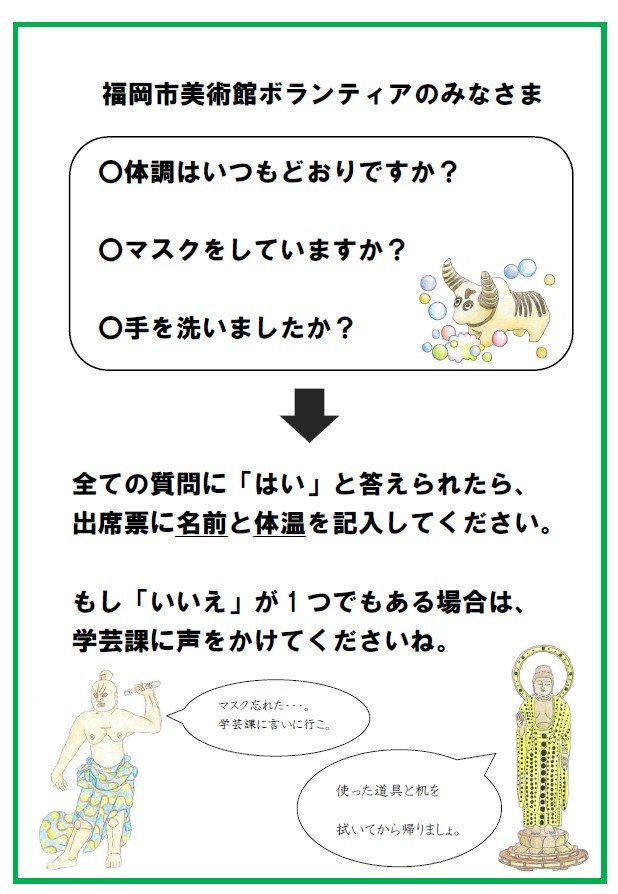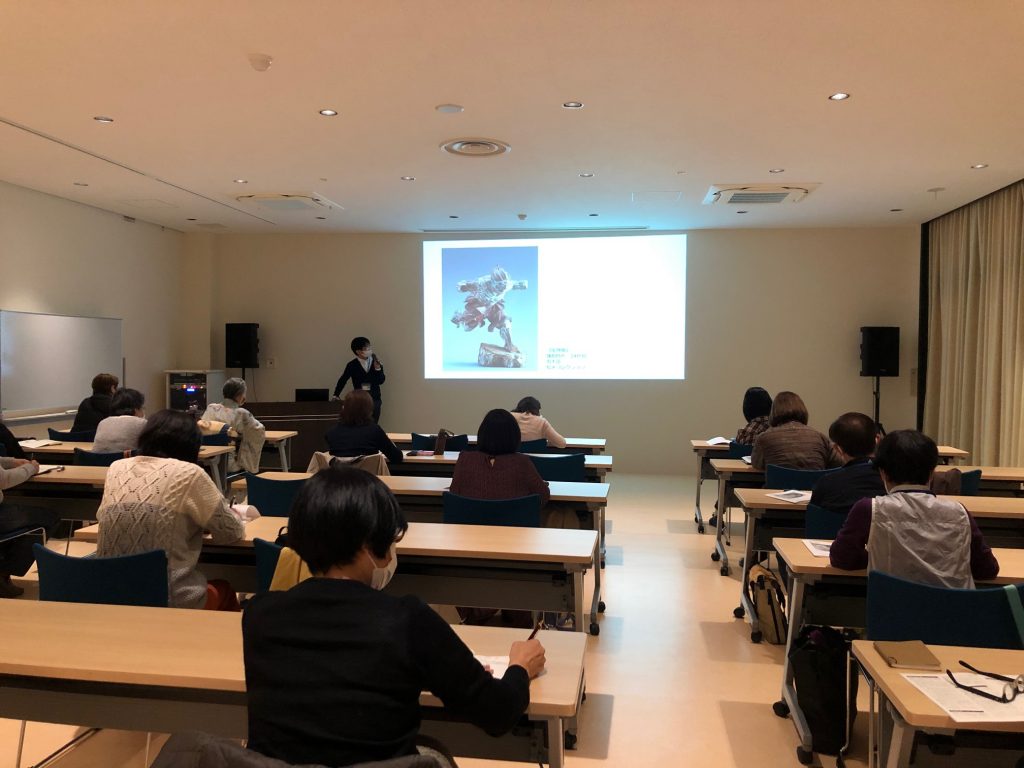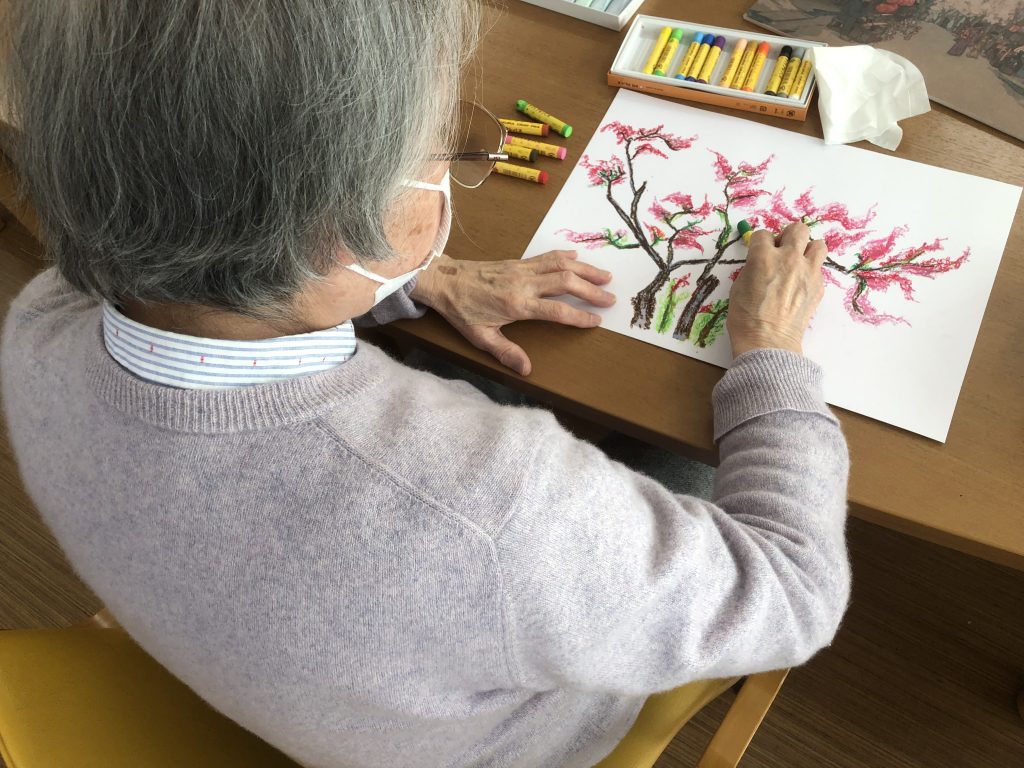
July 15, 2021
The Efforts of Fukuoka Art Museum During the Pandemic – Keeping the Human Connection
[2021.7.15]
Kayoko Onimoto
Senior Educator, Fukuoka Art Museum
The first coronavirus broke out in Fukuoka Prefecture on February 20th, 2020, and soon after, Fukuoka Art Museum where I work closed its doors temporarily. It was decided one week later, on February 27th that eight institutions run by the city of Fukuoka would close temporarily until March 20th. We reopened on March 21st only to close again on April 4th. Remote working was implemented from April 15th to May 13th, and only two curators were allowed to commute per day. We reopened for the second time on May 19th.
During this time, the special exhibition “Five Ukiyo-e Favorites” had hardly been open for viewing before coming to an end, school visits to the museum, and all workshops and lectures were canceled. Education curators like myself worried about the abrupt halt of all volunteer activities, especially for the volunteers who had applied in 2019 were finally about to complete their training at the end of the fiscal year. We misjudged the severity of the situation and expected the training to restart after a while but to no avail. We were at a standstill. During this unexpected intermission, would the new and even seasoned volunteers be discouraged?
Communication with the Volunteers
First, allow me to elaborate briefly about the volunteer program at the museum. The volunteer program started in 1976, three years before the grand opening of the Fukuoka Art Museum. Since then, the institution has recruited and trained volunteers in succession. As of June 2021, we have 171 registered and active volunteers working in four different branches: Newspaper Clipping Volunteers are assigned to clip newspaper articles, Library Assistant Volunteers assist with the maintenance of the library, Artist Data Management Volunteers (aka DM Volunteers) manage direct mail for exhibitions, and Gallery Guide Volunteers conduct the gallery tours.
One or more curators are assigned to lead each group. Education curators oversee preparations concerning new applicants and the overall training schedule, but cooperation from the administration staff is required at times. Not only that, but volunteer training lasts for roughly six months. As a result of the long-term, comprehensive training and the close supervision by a curatorial staff assigned to each group thereafter, communication between the volunteers, and communication between volunteers and curatorial staff are smooth and amicable. I believe that the energy source that permeates through all activities is communication.
But the temporary closure of the museum came abruptly. How can we maintain the same level of communication with our volunteers who physically cannot come to the museum? After much deliberation and gathered intelligence, the education curatorial team came up with the idea of sending out “newsletters” to the volunteers. One curator from our team would be in charge and create newsletters about activities within the museum during the closure. This would then be sent via email or post to the volunteers. To make the newsletter bilateral, we asked for opinions from the volunteers about art-related articles, book recommendations, artists, and artworks that they are focusing on, and included their answers in the newsletter. This newsletter continued to be sent out until volunteer activities resumed.
On July 1st, 2020, activities recommenced for the Newspaper Clippings Volunteers, Library Assistant Volunteers, and the DM Volunteers – but with limitations. We had to create our own set of rules about Covid-19 for the volunteers based on the guideline sanctioned by the museum and create a schedule so the volunteer room will not be overcrowded.

During this time, the newly recruited volunteers were finally able to complete their training. The only concern left pertained to the Gallery Guide Volunteers. Gallery tours were still suspended. As a result, we decided to hold study groups (with limited attendance) once a month in the Art Studio that was ordinarily used for workshops. And since entries to the exhibition rooms for tours were prohibited, we used projectors to makeshift a mock tour so that the volunteers could practice. We also gave special permission to the Gallery Guide Volunteers to gather in small numbers for a study group, provided they consult with the education curators beforehand and sanitize the room after use. The gallery tour has been and is still suspended, indefinitely. Perhaps inspired by the study group, the volunteers have expressed their wish to conduct a virtual gallery tour, which we have been gradually working on realizing.

New Endeavors During the Coronavirus Pandemic
The virtual gallery tour that I mentioned previously is not our only foraging into the digital. I’m sure with many other museums after the first temporary closure, we frequently updated our blog and SNS to introduce artworks, created and uploaded videos, as well as offer a free downloadable coloring sheet. The internet proved to be the best and perhaps only effective method to deliver information about the museum directly to the viewer during the closure. Last year when we organized the “Children’s Art Museum in Summer Vacation” (a special educational program that we hold every summer for children), we decided to utilize an online meeting system for an interactive online gallery talk event. Other in-person programs had restarted in June 2020, but for the Children’s Art Museum in Summer Vacation, we decided to limit the number of attendees as a safety measure and offered an online program for those who were worried and/or did not want to gather in public. Since then, we have been able to provide both in-person and online options for a majority of our regular educational programs.
Amidst these changes, we experimented with the online meeting system for other projects. The Fukuoka City Museum, Fukuoka Asian Art Museum and Fukuoka Art Museum came together to hold a reminiscence program for dementia patients. This program was entrusted to us by the Agency of Cultural Affairs as part of the 2020 Strategic Project to Create Culture and the Arts《Ensuring profitability and strengthening operations by “creating new relations” among museums.》This program would not have been realized had there not been a global pandemic.
The program itself is quite simple: it is to communicate with the participants through each museum’s collection. We requested cooperation from the city of Fukuoka’s Public Health and Welfare Bureau, and they introduced us to a day care center where three dementia patients were chosen to participate in the program. The program focused on the theme of “family” and was divided into five parts.
The first day was an introductory meeting. On the second day, nostalgic pop songs and old photographs from the Fukuoka City Museum archives were used to perform reminiscence therapy. Through these items, we asked the participants to tell us about the kind of music that they used to listen to, and for those who moved to Fukuoka, to tell us about their experience upon arriving back in the day. On the third day, the Fukuoka Asian Art Museum provided illustrations of family-related works from their collection. The participants shared stories of family memories and afterward drew a picture of that recollection.
On the fourth day, artwork from our collection at Fukuoka Art Museum was used in the session. We had assembled an exquisite reproduction of Keisen Tomita’s (1879-1936) “Cherry blossoms in Omuro (1933)” at the day care center. The first part of the session was dedicated to appreciating the display. This work is a decorated folding screen adorned with cherry blossoms (as per the title), and although the reproduction was smaller than the original, it was still large enough to cover one side of the room. After the sessions, the staff at the care center said creating the space had a good influence on the participants and other center users. We asked the participants to talk about their memories of cherry blossoms with their families. Afterward, we asked them to draw cherry blossoms.
The fifth and final day was a session dedicated to reflection. It was a pleasant surprise to see a smile upon the participant’s face that wasn’t there on the first day. Another amazing progression was that dialogue was born between the participants. According to the nursing facility, there was a positive response within the staff there as well. Although I’ve worked on programs for senior citizens before, this was my first time working with elderly dementia patients. Furthermore, it was all conducted online. This experience proved to us that even the coronavirus pandemic cannot deter us from succeeding in new endeavors. It gave us hope.


Closing
I’ve examined two topics in this article: the furtherance of our volunteer activities and embarking on new projects under the influence of the pandemic. Both can be boiled down to the museum and its role in keeping the human connection alive. One thing I need to mention is that I could not have made this progress by myself. These programs were brought to life when collective knowledge transformed into team intelligence. The coronavirus pandemic forcibly put a wall between people, but even when we are physically divided, the wish of the people to stay connected has been the foundation for keeping the art museum’s programs alive. The arrival of the COVID-19 vaccines represents a light at the end of the tunnel, but we are still far from a return to normalcy. Nevertheless, our team will remain dedicated to reaching out to the people to keep the connection alive.
(Kayoko Onimoto)